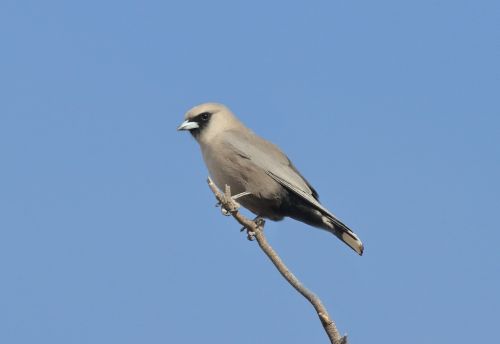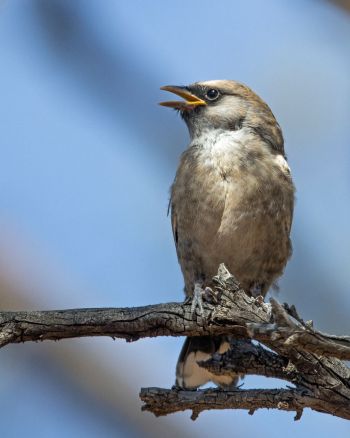Alternative names: Grey Woodswallow; Grey-breasted Woodswallow; White-bellied Woodswallow; White-vented Woodswallow (normani and dealbatus)
- Artamus cinereus
Identification
18cm
- Grey-brown above
- Black face around base of bill and eyes
- Light grey underparts
- Black tail feathers tipped white
- Bluish bill tipped black
- Black undertail in nominate
- Normani and dealbatus with white vent and undertail-coverts (not black)
Sexes similar. Juveniles are mainly brown, with extensive streaking, buff-brown underparts, pale brown bill.
Distribution
Australia, New Guinea, Lesser Sundas, including Timor.
Widespread and locally common.
Taxonomy
Subspecies
There are 5 subspecies[1]. The geographical variations of this species are complex and not yet fully understood.
- A. c. normani:
- Northern Queensland (south-eastern Cape York Peninsula)
- A. c. dealbatus:
- Eastern Queensland (Burdekin River to Burnett River)
- A. c. melanops:
- Interior of central Western Australia to central Queensland and northern Victoria
- A. c. cinereus:
- South-western Western Australia
- A. c. perspicillatus:
- Eastern Lesser Sundas
An additional subspecies albiventris is generally considered invald[1]
Habitat
Open country, open woodlands, around lakes and wetlands.
Behaviour
Diet
The diet includes aerial insects, also some nectar is consumed.
Forages singly or in pairs, also in small groups. Often seen in mixed-species flocks.
Breeding
Co-operative nesters. The nest is formed by twigs placed low in a small tree, stump or artificial structure. Lays 1 - 5 eggs.
References
- Clements, J. F., T. S. Schulenberg, M. J. Iliff, D. Roberson, T. A. Fredericks, B. L. Sullivan, and C. L. Wood. 2016. The eBird/Clements checklist of birds of the world: v2016, with updates to August 2016. Downloaded from http://www.birds.cornell.edu/clementschecklist/download/
- Del Hoyo, J, A Elliott, and D Christie, eds. 2009. Handbook of the Birds of the World. Volume 14: Bush-shrikes to Old World Sparrows. Barcelona: Lynx Edicions. ISBN 978-8496553507
- Avibase
- Birds in Backyards
Recommended Citation
- BirdForum Opus contributors. (2024) Black-faced Woodswallow. In: BirdForum, the forum for wild birds and birding. Retrieved 27 July 2024 from https://www.birdforum.net/opus/Black-faced_Woodswallow
External Links
GSearch checked for 2020 platform.1







